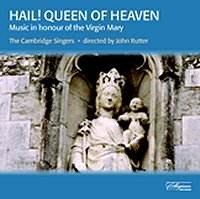This is one of a series of mid-price reissues of a
series which John Rutter originally made for his own Collegium label
in the late 1980s and early 1990s. As with their other reissues Collegium
have retained all the original notes by Rutter himself. These are excellent
and perceptive, and they also provide full texts and translations (other
labels, please copy!). I bought the original CD (then entitled ‘Ave
Gratia Plena’) and the only changes I can detect from the first release
is a different cover and the inclusion of a photograph of the performers
recording in the Lady Chapel at Ely Cathedral where, on the evidence
here, the acoustics are as magnificent as the architecture.
The thorough documentation does not indicate that the
original (very good) sound has been remastered. I thought that on an
A/B comparison I detected that the older recording sounded just a touch
fuller and richer with perhaps a degree of greater reverberation but
this may just be the sonic equivalent of a "trick of the light".
However, anyone investing in this CD will have no cause whatsoever to
complain of the quality of the recording which is excellent throughout.
The same is most certainly true of the performances
themselves. The chosen pieces encompass a range of styles but the choir
performs everything with easy, natural musicianship. The 28 voices blend
beautifully. The basses are firm but sound youthfully supple; there
is no hint of undue heaviness. The soprano line is possessed of a lovely,
ethereal purity (without ever sounding ‘pale’ or ‘white’) while the
inner parts are woven into the texture smoothly and seamlessly.
Rutter has chosen his programme shrewdly. It is divided
into four sections, each one corresponding to a segment of the church’s
year and each introduced by a mellifluously sung plainchant antiphon.
The sections are: Advent to Candlemas; Candlemas to Holy Week; Easter
to the Sunday after Pentecost; and Trinity to Advent.
So, there is variety in the programme but what does
not vary is the quality of the singing. The vocal blend is such that
we find the motet by Guerrero (track 2) unfolding serenely; every strand
of the polyphony is clear and carefully balanced. Indeed, this description
could apply equally well to any of the polyphonic items included here.
The well-judged recording balances the two SATB choirs distinctly for
the Palestrina Stabat Mater (track 7). This concise setting is
scrupulously phrased though I could imagine that some listeners might
prefer a more red-blooded choral sound.
The Bruckner motet (track 8) is distinguished by perfect
tuning – crucial for this kind of music. The dynamic control is very
impressive and Rutter’s singers have the necessary fullness of tone
for Bruckner’s climaxes. The Verdi, by contrast, is for women’s voices
only (track 9). It demands, and receives, pure and chaste singing.
Herbert Howells’ setting of Regina Caeli (track
13) is an early work, dating from 1916 when it was written for R. R.
Terry’s celebrated choir at Westminster Cathedral. It may be new to
some listeners. It lacks the harmonic luxuriance of some of the composer’s
more mature vocal works, perhaps, but it is still a sumptuous celebratory
setting, elaborately laid out for double choir. Terry’s choir, not long
established when Howells delivered this piece, must have been a very
capable group to do the work justice. Though the work is celebratory
it concludes with rapt alleluias which are a lovely surprise.
Rutter is understandably very fond of English music
but he is also an enthusiast for French music. The lovely Hymne à
la Vierge of Pierre Villette (track 15) is an adroit choice. Its
sinuous melody is supported by subtle, piquant harmonies and the whole
piece has a winning fluency and is full of Gallic richness. As Rutter
says in his notes, it is redolent of the music of Poulenc and will certainly
appeal to anyone who loves the music of that French master. It is, in
short, an exquisite miniature and it is beautifully done.
I’m afraid that the one piece on the disc with which
I can’t get on is Giles Swayne’s Magnificat (track 16). Dating
from 1982, it is apparently based on a Senegalese ploughing song. I
initially encountered it when I bought this disc first time round and
since then I’ve heard a number of different performances, both recorded
and ‘live’ but have never been persuaded by it. I’m sure the fault is
mine for it is a vigorous and rhythmically strong piece built from melodic
fragments. No doubt many listeners will respond more positively to it
than I do. Certainly it could not wish for more committed advocacy than
it receives here.
To follow the Swayne the choir treats us to more polyphony,
by Byrd and Victoria as well as a little-known but lovely Ave Maria
by Holst (track 20). The gorgeous yet simple setting of that same text
by Victoria (track 21) with which the recital ends typifies the dedication
and musicianship which has been lavished on the contents of this CD.
It would be hard to imagine a lovelier disc. Individual
items give great pleasure but the programme has been so planned that
it is perhaps best enjoyed by listening straight through, just allowing
a few minutes pause between each of the sections. This is an excellent
example of what can be achieved by a smallish choir of expert singers
under the direction of a first class choral conductor. It is a disc
which is even more attractive now that it has been reissued at medium
price. It has given me a great deal of pleasure over the last ten years
or so and I have no hesitation in recommending it to new listeners and
to those who may have missed it first time round.
John Quinn



